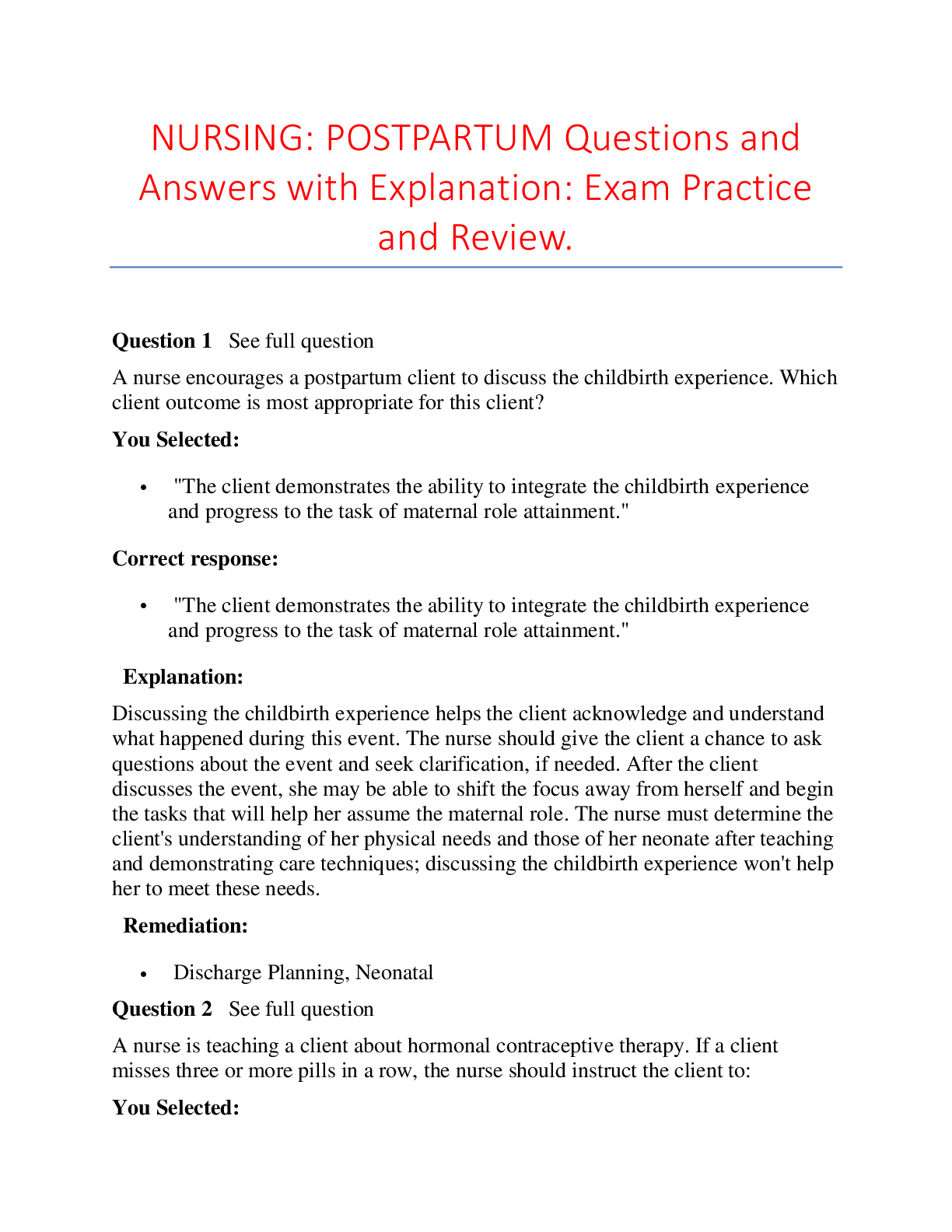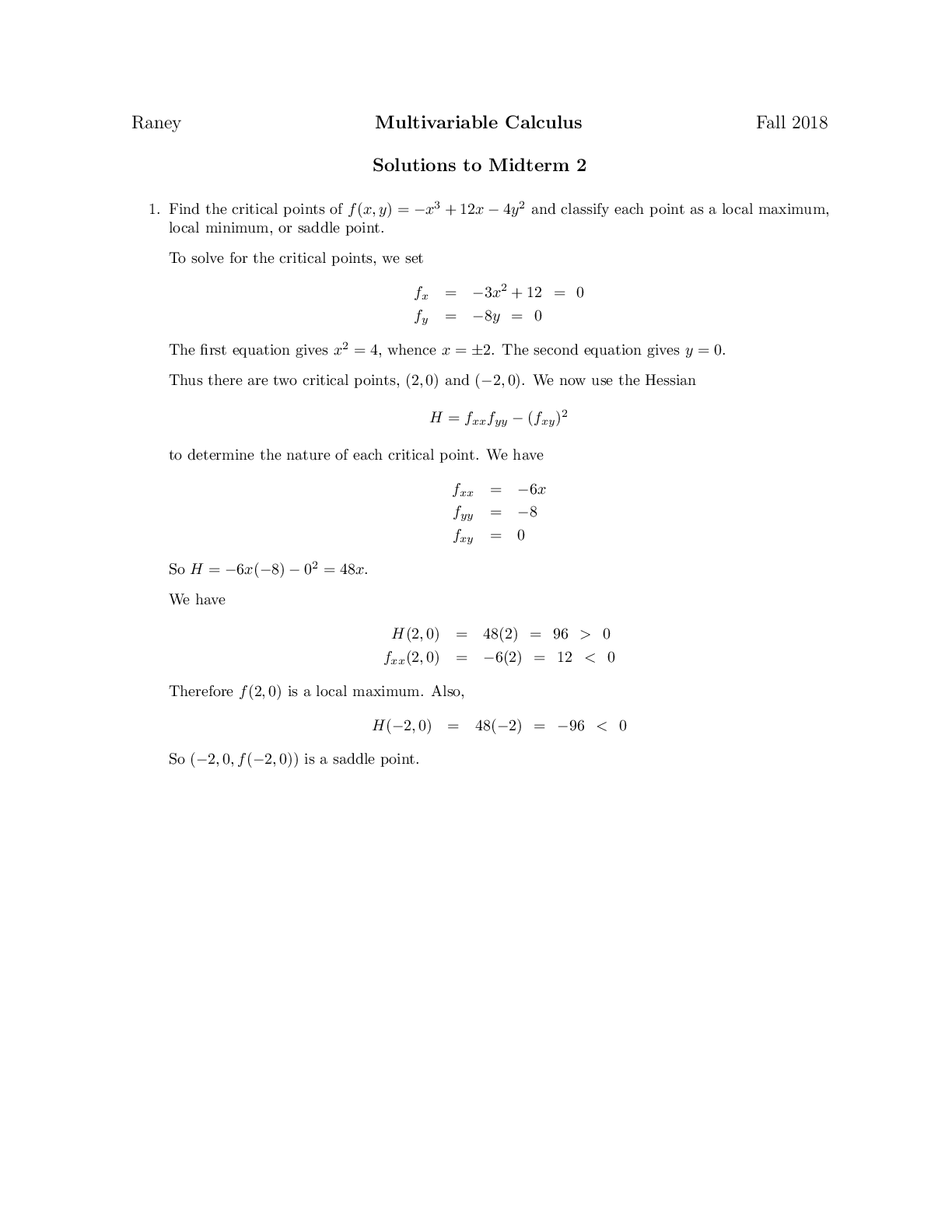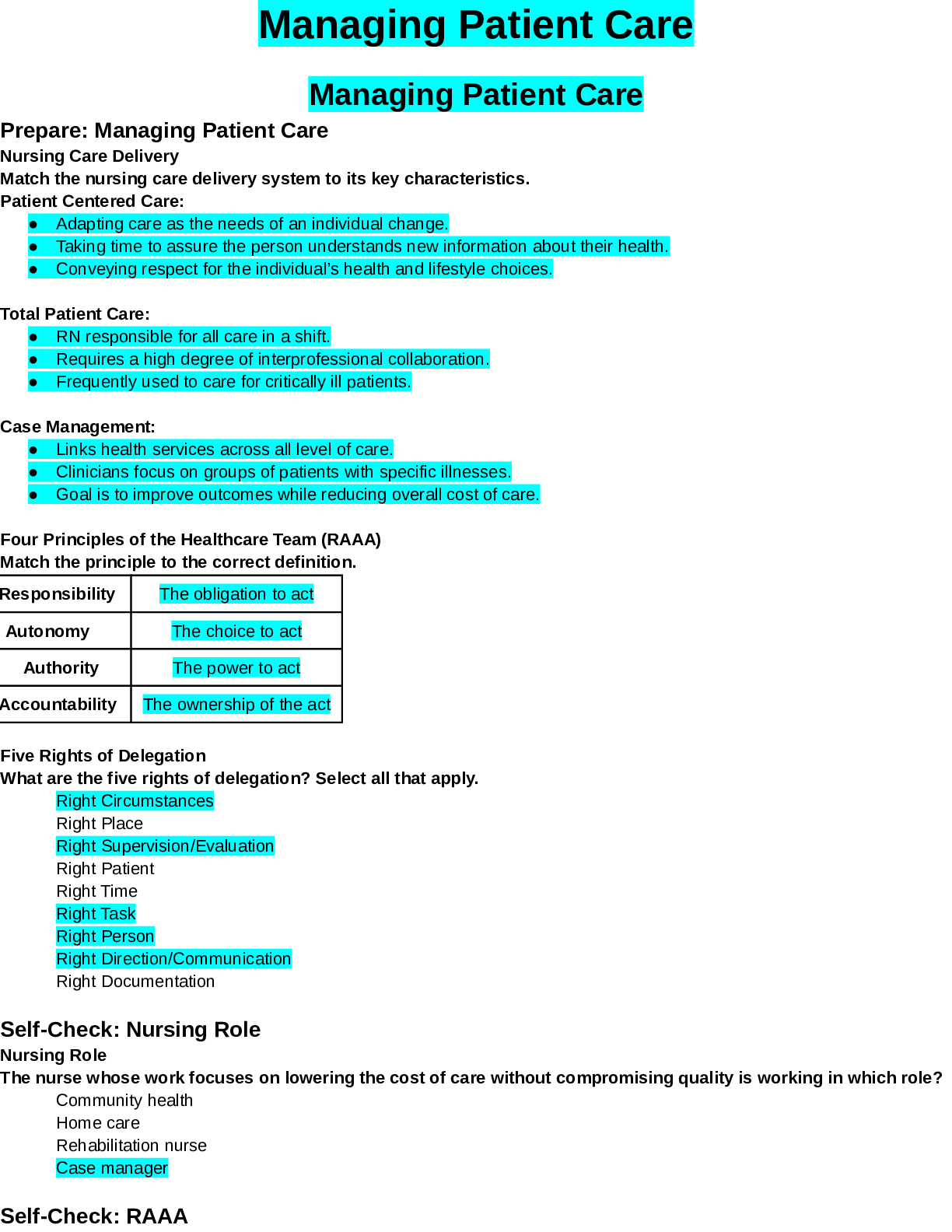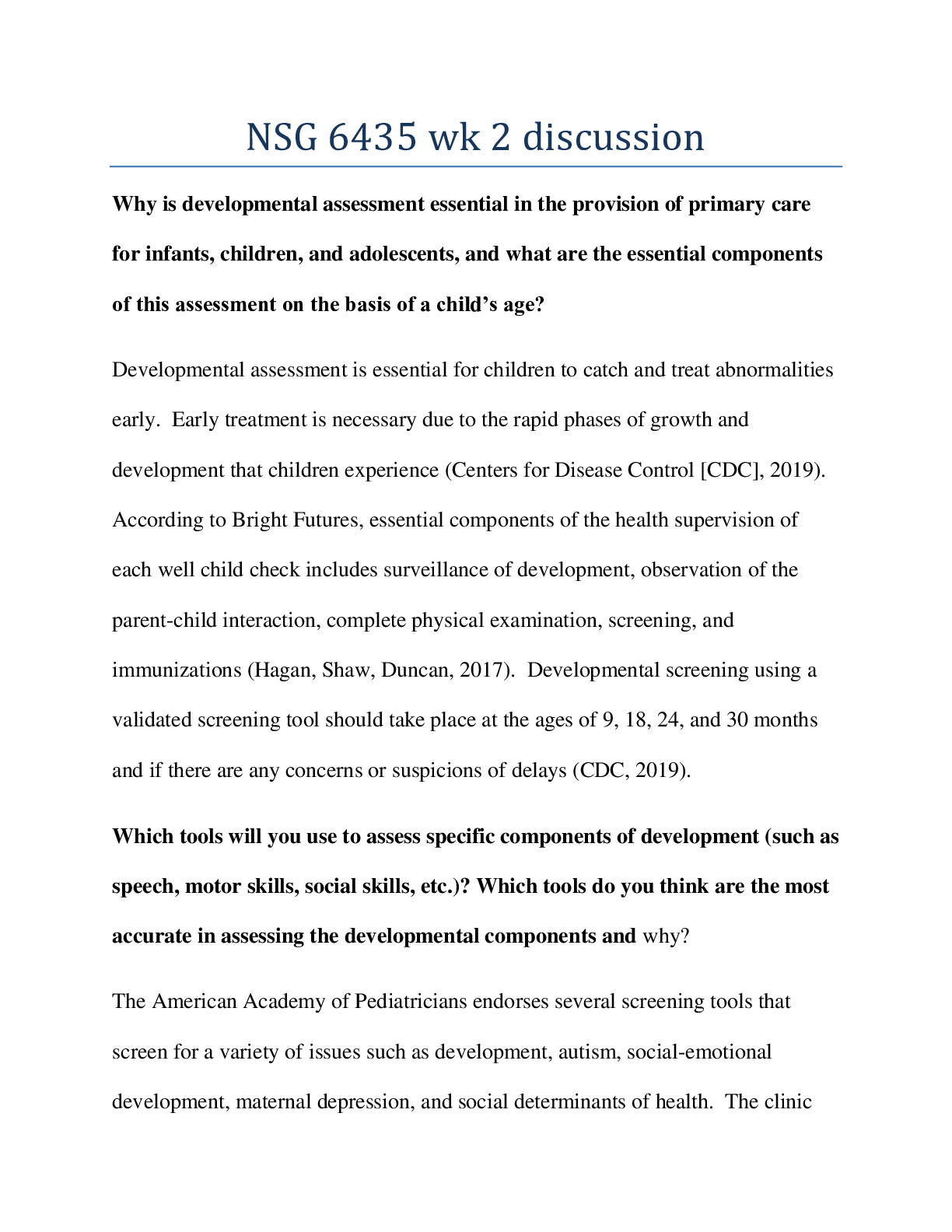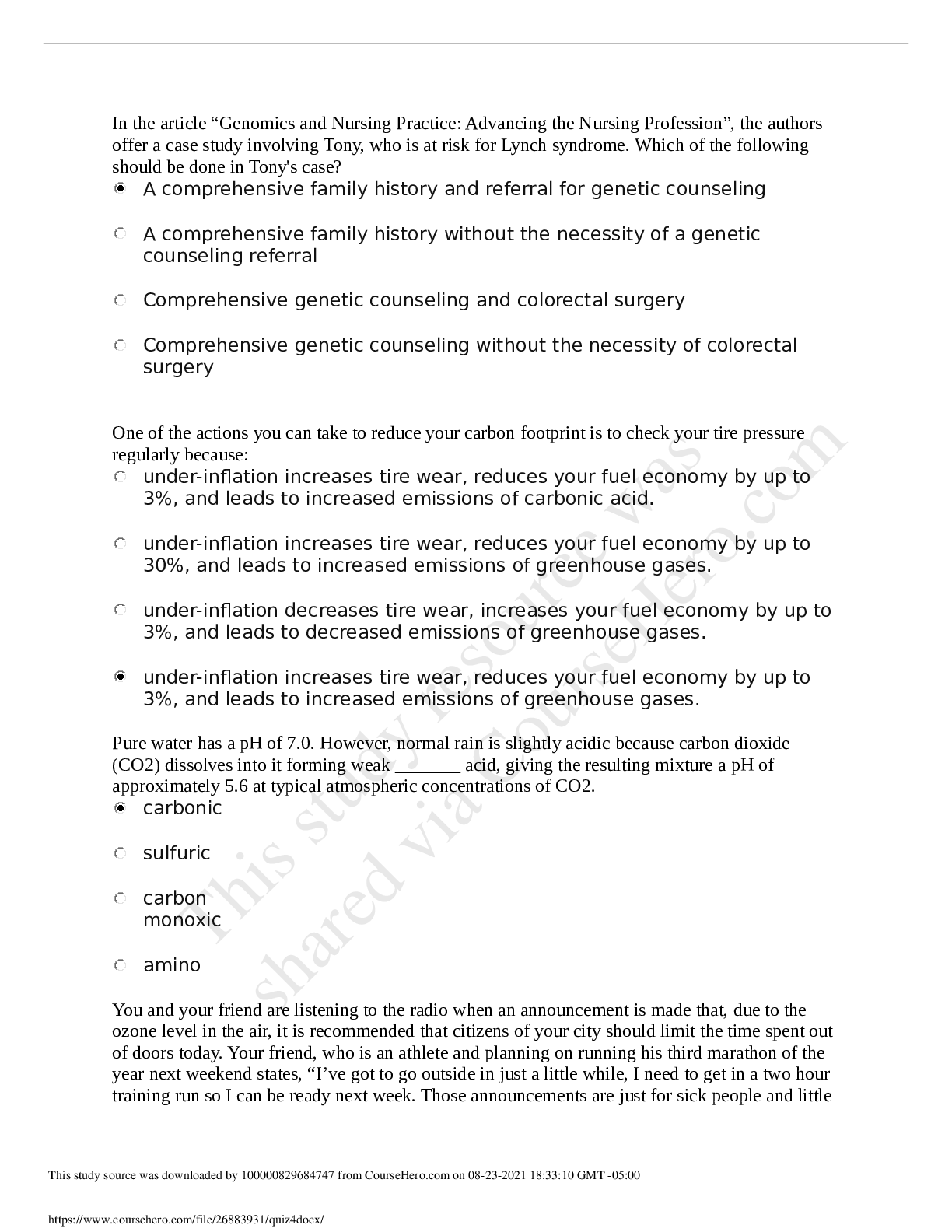Biology > QUESTIONS & ANSWERS > North Carolina State University. WebAssign. BIO 183 Final Exam. Current Score : 77.5 / 100. 37 Most (All)
North Carolina State University. WebAssign. BIO 183 Final Exam. Current Score : 77.5 / 100. 37 Most Occuring Questions and Answers.
Document Content and Description Below
BIO 183 Final exam 1/24/12 7:02 PM Current Score : 77.5 / 100 Due : Tuesday, December 13 2011 09:00 PM EST 1. 5/9 points Match each neurological term to its meaning. (Two answers are not used.) ... when the inside of the neuron becomes more positive than the resting potential depolarization a large depolarization that carries an electrical signal along the axon action potential covers the axon and makes electrical conduction more rapid myelin sheath ions that enter the neuron and initiate electrical conduction along the axon acetylcholine a neurotransmitter that passes an electrical signal from one neuron to another dendrite a neuronal fiber that conducts an electrical signal toward the cell body sodium a neuronal fiber that conducts an electrical signal away from the cell body potassium the difference between electrical charges on each side of the neuron's membrane membrane potential a small space that separates an axon from another neuron synapse synapse 2. 2/2 points What is the function of homeotic genes in animal development? BIO 183 Final exam (Exam) Thomas Nader BIO 183, section 601, Fall 2011 Instructor: Betty Black WebAssign The due date for this assignment is past. Your work can be viewed below, but no changes can be made. BIO 183 Final exam 1/24/12 7:02 PM ?dep=3670477 Page 2 of 16 3. 2/2 points In mammals, hormone signals are required for 4. 2/2 points Which of the following are stem cells that can produce all cell types in the human body? They store information within the cytoplasm of the ovum. They control the process of metamorphosis. They control whether an animal is male or female. They control the development of individual body segments. none of these expression of homeotic genes development of female characteristics of an embryo none of these sex differentiation of both male and female embryos development of male characteristics of an embryo Cells in the bone marrow of an adult. Cells in the testes that normally produce sperm. Cells from the inner cell mass of a blastocyst. all of these Cells in the brain tissue of an adult. BIO 183 Final exam 1/24/12 7:02 PM ?dep=3670477 Page 3 of 16 5. 2/2 points Which of the following animals have been used as models organisms in studies of development? 6. 2/2 points How do biologists use restriction enzymes? 7. 2/2 points A cDNA probe is made by the fruit fly all of these the roundworm, C. elegans the zebra fish the domestic chicken to cut RNA into several large fragments none of these to cut DNA into thousands of 4-nucleotide fragments to restrict the replication of DNA within cells to cut DNA at specific nucleotide sequences to produce DNA fragments using reverse transcriptase to copy pre-mRNAs from the nucleus of cells using reverse transcriptase to copy mRNAs from the cytoplasm of cells none of these using fluorescent nucleotides to label RNA with cells using reverse transcriptase to copy DNA from the nucleus of cells BIO 183 Final exam 1/24/12 7:02 PM ?dep=3670477 Page 4 of 16 8. 2/2 points A genome is 9. 2/2 points In eukaryotic organisms, mitochondrial DNA 10.2/2 points What was the purpose of the human genome project? all of the proteins present within a cell all of the genes present within a cell all of the mRNA present within a cell all types of RNA present within a cell none of these is not passed from parent to offspring is inherited from both parents is inherited only from the female parent is only present if the offspring has been infected by a virus is inherited only from the male parent BIO 183 Final exam 1/24/12 7:02 PM ?dep=3670477 Page 5 of 16 11.2/2 points BBiology1 19.1.001. Which of the following is a major function of B lymphocytes? 12.2/2 points BBiology1 19.2.001. An antibiotic (such as penicillin) works by To determine whether all humans have the same type of genes none of these To determine the nucleotide sequence of all DNA in human cells To determine which genes are expressed in each type of human cell To determine the amino acid sequence of all proteins in human cells engulfing bacteria by phagocytosis secreting cytokines to stimulate the proliferation of other lymphocytes attacking cells infected by a virus attacking cancerous cells secreting antibodies killing viruses only. neutralizing bacterial toxins. killing bacteria only. destroying all antigens present in the body. killing both bacteria and viruses. BIO 183 Final exam 1/24/12 7:02 PM ?dep=3670477 Page 6 of 16 13.2/2 points BBiology1 19.5.002. Which of the following is a true statement about plasmids? 14.2/2 points BBiology1 19.6.001. AIDS is a disease that is caused by 15.2/2 points BBiology1 19.8.001. Which of the following happens when a DNA-containing virus infects a cell? They prevent bacteria from mating with one another. They contain more genes than the bacterial chromosome. They are short, straight segments of DNA. They enable some bacteria to utilize rare nutrients. They are found in bacteria, viruses and fungi. a bacteria that kills macrophages. a virus that infects B lymphocytes. a virus that infects helper T lymphocytes. a prion that destroys lymphocytes. a viroid. The virus becomes a symbiont of the cell. The host cell uses the viral enzyme "reverse transcriptase" to make a copy of viral DNA. The virus may cause Mad Cow disease. The host cell transcribes the viral DNA and produces new viral components. The virus provides ATP for the cell. BIO 183 Final exam 1/24/12 7:02 PM ?dep=3670477 Page 7 of 16 16.2/2 points BBiology1 21.1.001. What is the purpose of a vector in gene cloning procedures? 17.2/2 points BBiology1 21.3.001. One important use of knockout mice is 18.2/2 points BBiology1 21.4.001. The purpose of the polymerase chain reaction (PCR) is to The vector allows a gene of interest to be taken up and replicated by bacteria. The vector binds to a specific gene, allowing it to be identified. The vector has no real purpose. The vector rapidly replicates DNA when primers are added and thermocycling is employed. The vector cuts DNA at specific places to produce DNA fragments. to produce the genes for human gene therapy. to serve as models for human diseases. to produce vaccines. to serve as vectors for gene cloning. to produce human hormones. BIO 183 Final exam 1/24/12 7:02 PM ?dep=3670477 Page 8 of 16 19.0/2 points BBiology1 21.5.001. Which of the following is an important use of recombinant bacteria? 20.0/2 points BBiology1 21.6.001. Which of the following is a goal of reproductive cloning? 21.2/2 points BBiology1 22.2.001. The membrane structure shown by the arrow is a produce recombinant DNA. produce DNA. clone genes. clone animals. produce human hormones. DNA fingerprinting to clone endangered species None of these. to identify unknown genes to produce human hormones to clean up chemical spills in the environment to use domestic animals to produce human proteins to propagate endangered animal species to produce human tissues for transplantation to produce genetically modified foods BIO 183 Final exam 1/24/12 7:02 PM ?dep=3670477 Page 9 of 16 22.2/2 points BBiology1 22.3.001. The fluidity of membranes will increase if 23.0/2 points BBiology1 22.4.001. A very small, polar molecule usually crosses the plasma membrane by cholesterol transmembrane (integral) protein pheripheral protein phospholipid carbohydrate group of a glycoprotein there are more saturated fatty acids. None of these. there are more peripheral proteins. the temperature decreases. there are more unsaturated fatty acids. BIO 183 Final exam 1/24/12 7:02 PM ?dep=3670477 Page 10 of 16 24.2/2 points BBiology1 22.6.001. Which of the following is an example of pinocytosis? 25.0/2 points BBiology1 22.7.001. The membrane protein shown here is functioning as a by phagocytosis. facilitated diffusion using a protein carrier. through a protein channel. active transport using a protein carrier. simple diffusion through the lipid layers. a cell taking in small amounts of liquid by bulk transport a cell co-transporting sodium and glucose a cell secreting a liquid product a cell using ATP to accumulate large amounts of potassium a macrophage engulfing a yeast cell BIO 183 Final exam 1/24/12 7:02 PM ?dep=3670477 Page 11 of 16 26.2/2 points Which of the following human hormones is produced by the pancreas? 27.0/2 points BBiology1 23.1.001. Which of the following is most likely to occur when a signaling molecule binds to an enzyme-linked receptor? 28.2/2 points BBiology1 23.2.001. Which of the following molecules is a common second messenger in signal transduction pathways? antiporter. gated channel. symporter. passive carrier. bulk transport system. auxin insulin thyroxine none of these epinephrine the receptor is split into several products a membrane-bound protein binds GTP and is split into subunits a protein channel opens and ions enter the cell a protein is phosphorylated using ATP the membrane potential changes BIO 183 Final exam 1/24/12 7:02 PM ?dep=3670477 Page 12 of 16 29.2/2 points BBiology1 23.3.001. Which of the following is an example of direct intracellular signaling? 30.0/2 points BBiology1 23.10.003. The stimulus that releases neurotransmitters from a neuron is 31.0/2 points BBiology1 23.12.001. epinephrine ATP caffeine phosphodiesterase cyclic AMP a molecule that passes from the cell of origin to neighboring cells by moving through gap junctions a yeast cell that senses glucose in its environment a molecule on the surface of one cell that binds to the receptor of an adjacent cell a molecule that travels through the bloodstream from its site of origin and binds to the receptor of a distant cell a molecule that diffuses a short distance from its site of origin and binds to a receptor of a nearby cell an elevation of GTP. an elevation of cyclic AMP. the influx of calcium ions. release of acetylcholine. generation of ATP. BIO 183 Final exam 1/24/12 7:02 PM ?dep=3670477 Page 13 of 16 Which of the signals below cause a mimosa leaf to rapidly close when touched? 32.4/4 points Regarding gene technology, define the term "homologous genes" and indicate why they are important in biological research. The term homologous genes refers to genes that are similar in nucleotide sequence. They are important in biological research because they could be used to understand the similarity between genes of different species and where they derived from. Score: 4/4 Grader: Miller TA, Elliott 33.4/4 points Regarding bacterial genetics: a) Name two ways in which DNA can be transferred between bacteria b) Describe (in general terms) how each of these transfer occurs. a) Two ways in which DNA can be transferred between bacteria is by transformation or transduction. b) Transformation occurs when bacteria can essentially pick up nearby naked DNA from dead bacteria. Transduction occurs when a virus transfers DNA from one bacterium to another. Key: generation of an electrical signal absorption of light by phytochromes a change in the position of statoliths within leaf cells a change in auxin distribution secretion of cytokinins BIO 183 Final exam 1/24/12 7:02 PM ?dep=3670477 Page 14 of 16 34.4/4 points Regarding the production of transgenic multicellular organisms: a) Define the term "transgenic animal". b) Describe, in general terms, one way in which transgenic animals are produced. a) A transgenic animal is an animal that has been given certain genes of interest in order to either prevent certain diseases or obtain certain traits. b) A transgenic animal could be produced by inserting a certain gene of interest into the embryo of an animal, before development begins. Score: 4/4 Grader: Spangler TA, Hillary 35.4/4 points Regarding the transport of molecules across the plasma membrane: a) Compare the processes of facilitated diffusion and active transport. b) Indicate which or these processes requires energy and why. a) Facilitated diffusion is a process which involves certain concentration gradients and molecules that are moved by diffusion to an area of less concentration by an ion gate or channel. Active transport is the process in which membrane-bound proteins actively transport molecules across the plasma membrane to certain areas. b) Active transport requires energy because it is usually going against a concentration gradient and therefore cannot be transported by itself and requires a membrane-bound protein. BIO 183 Final exam 1/24/12 7:02 PM ?dep=3670477 Page 15 of 16 Score: 4/4 Grader: Squires TA, Jordan 36.0.5/3 points Indicate one function for each of the following in plant life: a) jasmonic acicd b) phytochromes c) cytokinins a) prevent water loss b) help receive sunlight c) help control movement 37.10/12 points Hormones comprise one means of communication within the body of multicellular organisms, especially animals. The two main types of hormones found in animals have the general structure of a protein or a steroid. Compare these two types of hormones, regarding: a) their biochemical structure b) where/how they are produced within a cell c) the mechanism by which they produce a response within their target cells. a) In regards to their biochemical structure, a protein is an amino acid with a central carbon, surrounded by a carboxyl group, an amine group, a hydrogen group, and a side 'R' group, all folded. A steroid has a 4-fused ring structure, and is individually determined by its additional 'R' group that is attached to it. b) Proteins are produced in several parts of the cell, for instance the rough endoplasmic reticulum where ribosomes carry out protein synthesis. Also, in the nucleus, protein synthesis is begun by transcription of BIO 183 Final exam 1/24/12 7:02 PM ?dep=3670477 Page 16 of 16 a DNA strand into an RNA strand. Then the RNA is taken to the cytoplasm from the nucleus and mRNA attaches it to a ribosome, where translation of the complimentary DNA strand is carried out. Steroids are synthesized from cholesterol, mainly in the adrenal glands, and are controlled by the endocrine system. c) The mechanism by which proteins produce a response within their target cells is by second messengers, located on the plasma membrane. The mechanism for steroids is the initiation of gene transcription, in the nucleus or cytosol. [Show More]
Last updated: 2 years ago
Preview 1 out of 9 pages

Buy this document to get the full access instantly
Instant Download Access after purchase
Buy NowInstant download
We Accept:

Reviews( 0 )
$14.00
Can't find what you want? Try our AI powered Search
Document information
Connected school, study & course
About the document
Uploaded On
Apr 27, 2021
Number of pages
9
Written in
Additional information
This document has been written for:
Uploaded
Apr 27, 2021
Downloads
0
Views
151

